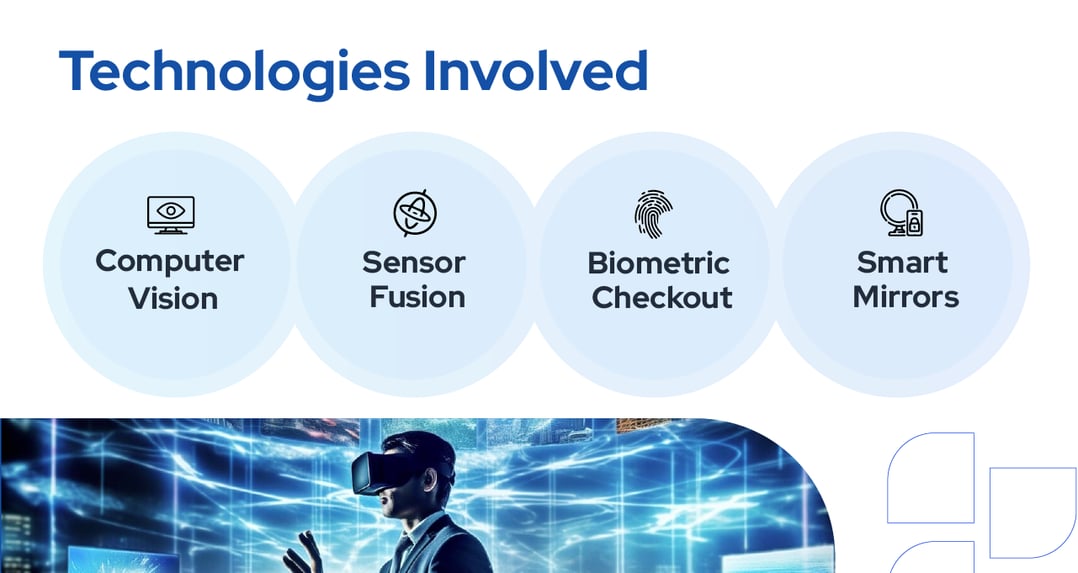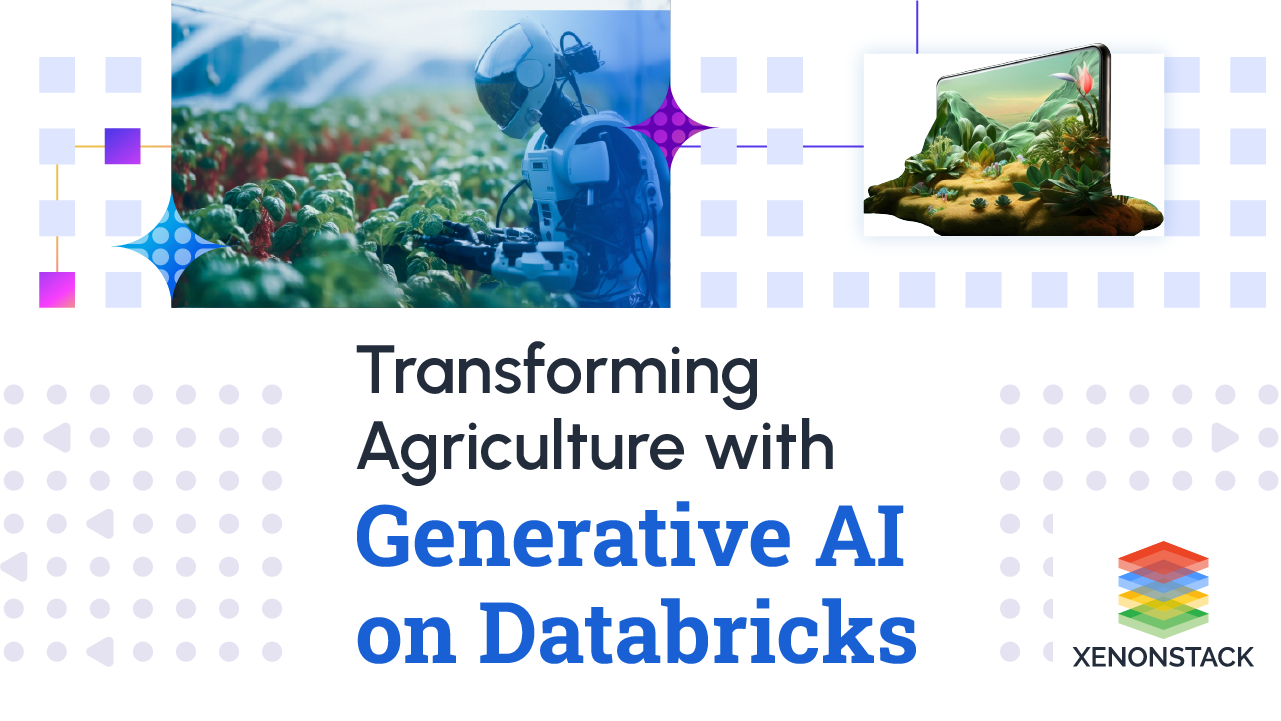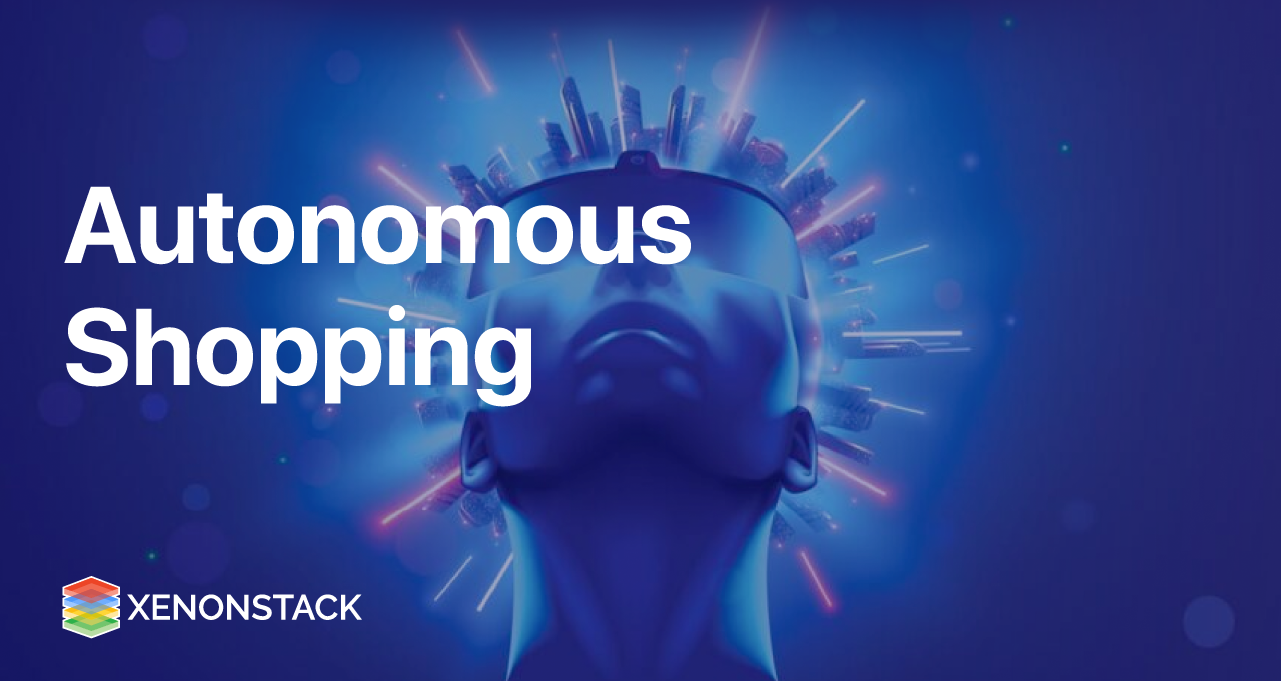
Autonomous stores have the potential to offer the best of both worlds - the convenience of online shopping and the physical experience of interacting with a product.
Just imagine walking into your favorite store, picking up the needed products, and walking out without waiting in long checkout lines or scanning items.
Autonomous stores can make this reality, and its what consumers are looking for in their shopping experience.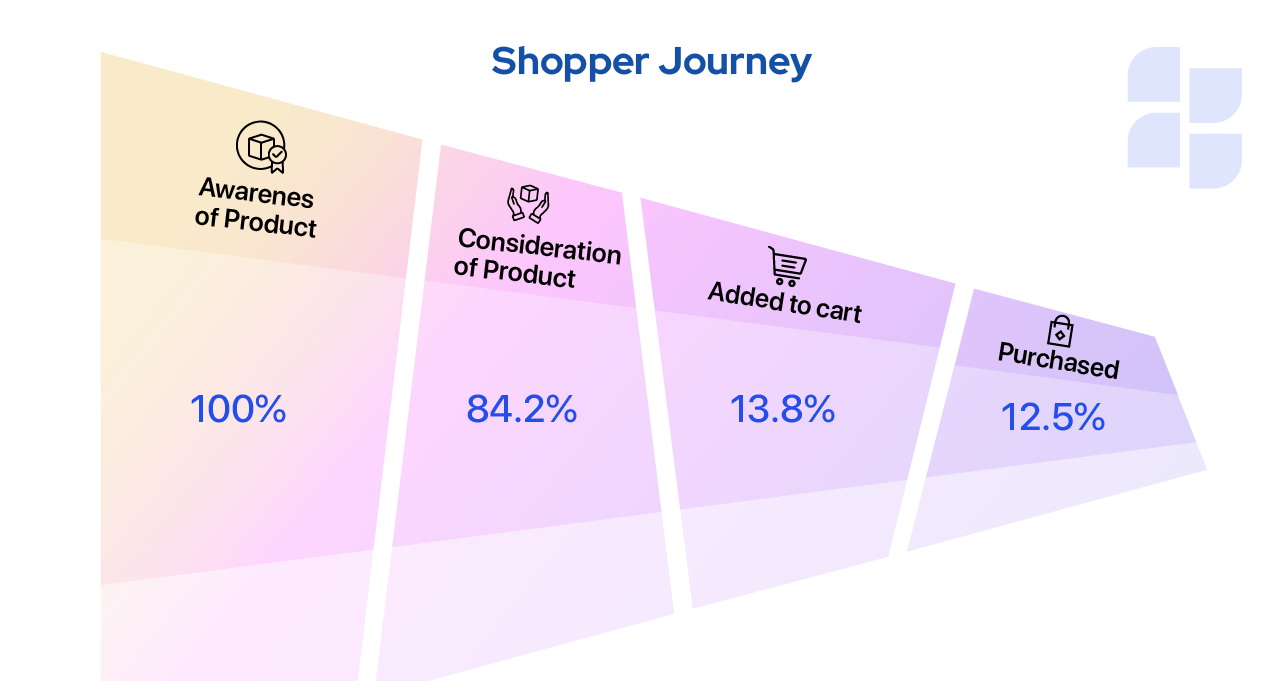 An autonomous store is a retail shop where customers can choose the items they want from the shelves, put them into their bags, and leave without going through the traditional checkout process. This process eliminates the need for cashiers or self-checkout stations, as customers can pay using the retailer's app or through a credit or debit card deduction.
An autonomous store is a retail shop where customers can choose the items they want from the shelves, put them into their bags, and leave without going through the traditional checkout process. This process eliminates the need for cashiers or self-checkout stations, as customers can pay using the retailer's app or through a credit or debit card deduction.
Why Autonomous Stores Matter Now ?
Retail customers' preferences have evolved due to the pandemic, and they now demand personalized and convenient shopping experiences. Autonomous retail can help businesses meet these changing preferences. A recent survey showed that 75% of retail customers prefer autonomous shopping experiences. As a result, modern retailers are modernizing their operations with technology to keep up with these changes.
Autonomous stores have the potential to combine the best of both worlds – the physical store experience of interacting with a product and the simplicity of an online checkout process. Imagine walking to your favorite store, picking up needed products, and simply walking out.
Innovative autonomous stores and seamless checkout experiences aim to eliminate three levels of pain points in the customer experience:
1. Interaction-Level Pain Points: These occur when customers spend a lot of time finding what they want.
2. Journey-Level Pain Points: These happen when customers must endure long, drawn-out shopping experiences that frustrate them and cause them to leave without purchasing.
3. Relationship-Level Pain Points: Customers are expected to watch ads or do other things to receive a service.
To delight shoppers, retailers must find ways to eliminate these pain points and provide a seamless, intelligent, and intuitive shopping experience. They can use in-store AI-driven technologies to reformulate their operations and use digital tools.
Era of Experiential Retail ?
Retail stores are losing market share to e-commerce and must focus on curated experiences, not just transactions, to engage customers and maintain their brand.
To achieve a good mind share at the physical stores, retail stores will need to integrate innovative and self-adapting technologies to create immersive and interactive customer experiences. For example, Sam's Club is a membership-only retail club owned by Walmart.
Here, Members can try out new technologies such as Smart Shopping List, which uses machine learning and purchase data to auto-fill member shopping lists. They can easily add or remove items, and as they scan items, the list automatically updates. The club also features augmented reality to showcase new product uses and features, electronic shelf labels that instantly update prices, and a camera system to manage inventory and optimize store layout for a seamless shopping experience. 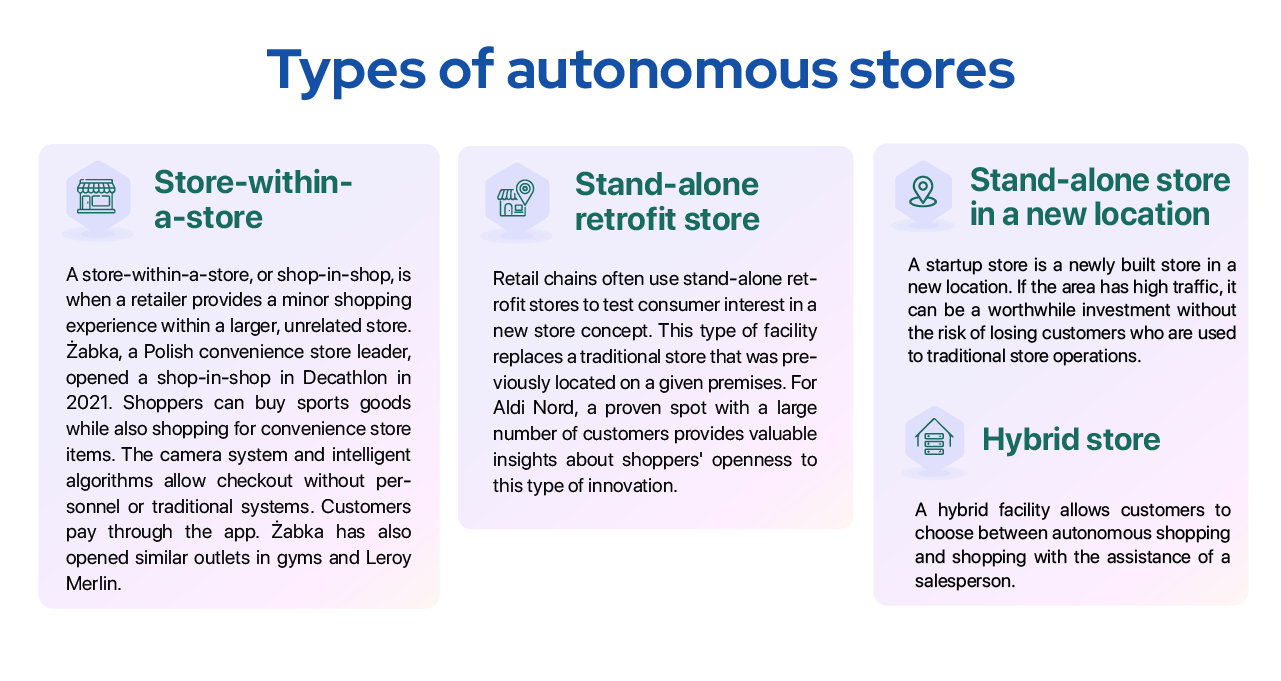
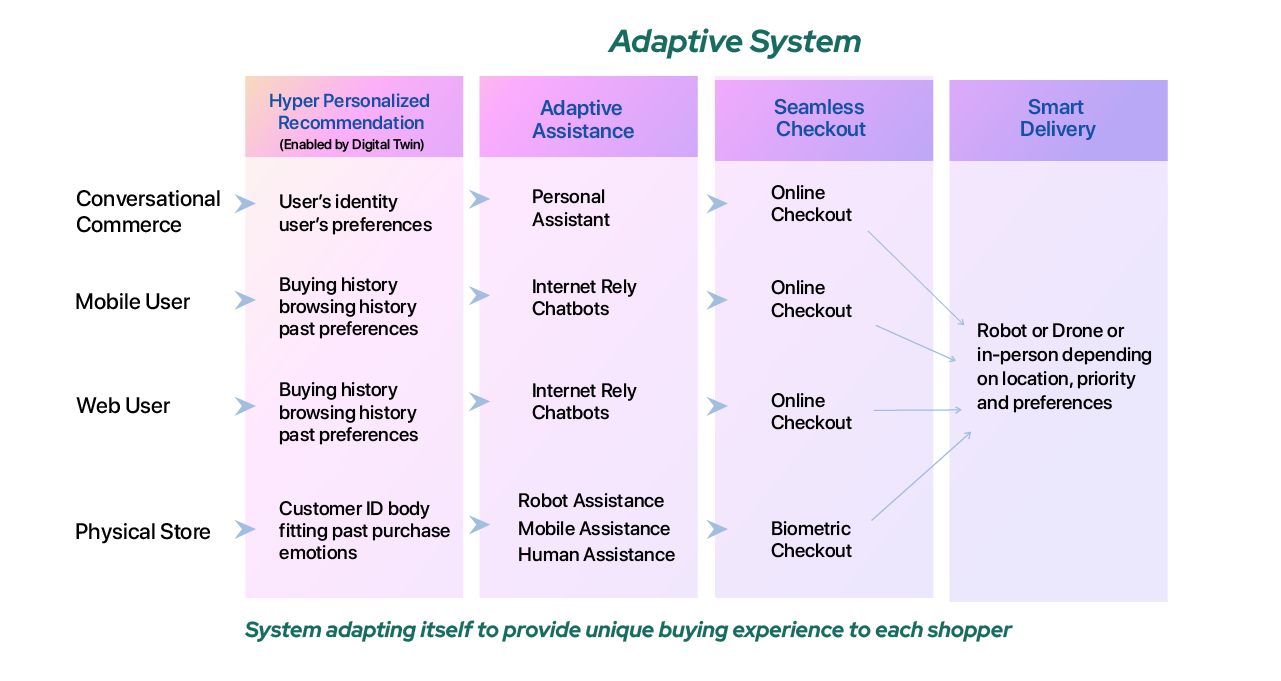 Comparison table of autonomous stores models:
Comparison table of autonomous stores models:
|
Type of Autonomous Store |
Description |
Pros |
Cons |
|
Store-within-a-store (a cooperative setup) |
A small autonomous store setup within a larger retail establishment |
- Easy access for customers to experience the new store format - Potential for sales synergies and cross-promotion between stores - Easier monitoring of customer responsiveness to technological innovations |
- Dependence on the entity providing space for the autonomous store - Limited assortment due to smaller size - Potential disruptions if the host store is closed for any reason |
|
Stand-alone retrofit store |
An existing traditional store converted into an autonomous store |
- Existing customer usage - A functional logistics chain |
- The need to adapt the store’s format to the existing location (potential high investment costs) - Potential loss of customers not comfortable with the change in the shopping format |
|
Stand-alone store in a new location |
A brand-new autonomous store built from scratch |
- Potential for a quick return on investment (ROI) in high-traffic areas - If built with a specific format based on established setups, saves time and money |
- Risk of low ROI if the location choice is poor and customer visits are infrequent - Potential competition from nearby franchisees or similar shopping points |
|
Hybrid store |
Store offering both autonomous and human-assisted shopping experience |
- Offering customers flexibility as a bridge between a modern shopping experience and human assistance when needed |
- Potential issues related to human interactions and assistance - May require additional preparation for seamless switching between autonomous and assisted modes - Maintains costs associated with the traditional shopping approach |
Retail of the future
Retail stores can boost customer loyalty by leveraging new technologies like machine vision, sensor fusion, real-time edge analytics, robots, and blended reality. By understanding customer context and behaviour, stores can offer hyper-personalized experiences, in-store engagement, and real-time assistance based on shopper needs. These initiatives can lead to better shopper experiences, increased revenue per shopper, and improved resource allocation by automating repetitive tasks.
Adaptive Retail
User Journey
Adaptive Retail Scenario
1. Sam sees a dress on a sponsored tweet while at a cafe, triggered by her shopping history and proximity to a mall.
2. A chat message reserves the dress for try-on at a nearby store.
3. At the store, body scanners determine Jane's size, and the correct dress is delivered to the trial room.
4. In the trial room, a smart mirror identifies the dress and suggests matching handbags.
5. Jane selects a handbag, and it's delivered to the trial room.
6. Pleased, Jane takes the dress and handbag to a shelf checkout kiosk with biometric authentication.
7. Secure payment is made, completing the seamless experience.
This adaptive retail scenario showcases a seamless and personalized shopping experience facilitated by an intelligent adaptive system, integrating various technologies for a smooth user journey.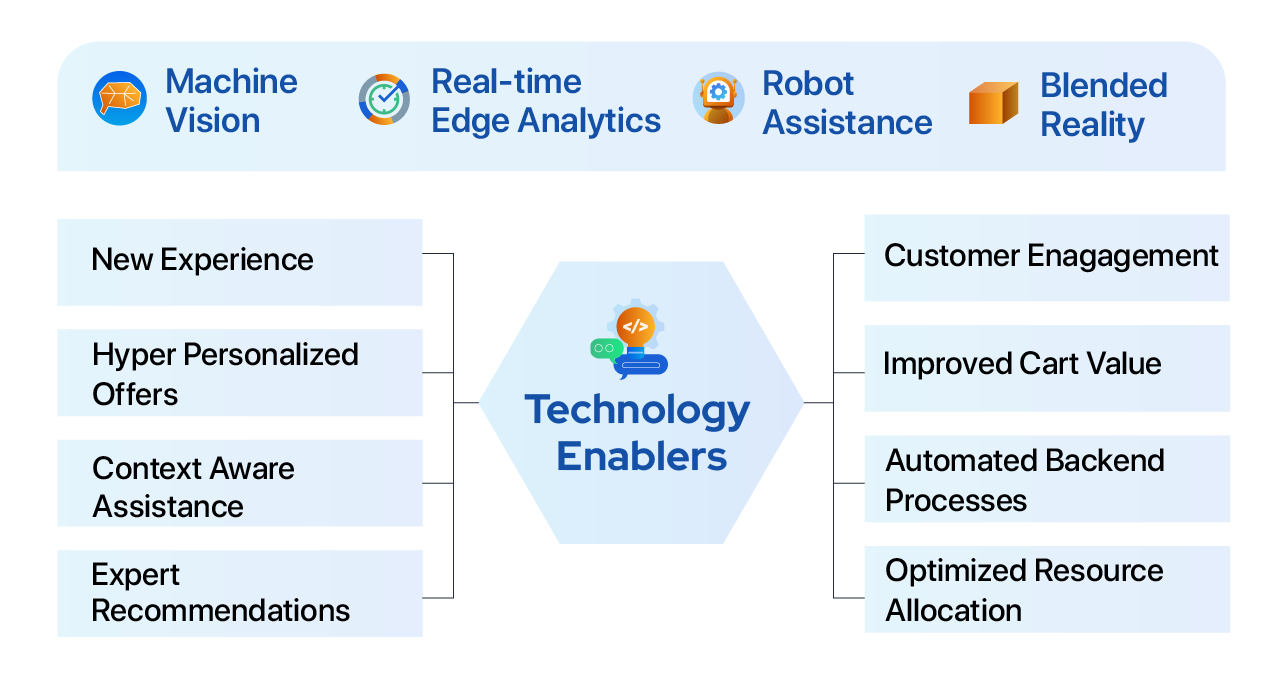
Innovations in Retail: A Comprehensive Overview
1. On-premises CCTV cameras used for customer identification in real-time.
Customer Identification System
2. Personalized greetings sent to new or repeat customers based on facial recognition.
3. Mapping of repeat customers to their shopping history and preferences for personalized recommendations.
4. Detection of individuals flagged as shoplifters by the system to prevent thefts and revenue loss.
This customer identification system utilizes on-premises CCTV cameras for advanced functionalities such as real-time customer recognition, personalized greetings, mapping customer profiles to shopping history, and the ability to identify flagged individuals as potential shoplifters, contributing to enhanced security and personalized customer experiences.
1. On-premises cameras function as in-store body scanners to capture precise body sizes.
Digital Twin System
2. Creation of a 3D profile of customers using the scanned body measurements.
3. Mapping of captured body measurements with corresponding common sizes for accurate recommendations.
4. Computer vision and sensor fusion for identifying items of interest and refining product recommendations based on recent interests.
5. Virtual cart integration for customers, allowing the addition of items of interest. 6. Real-time monitoring of stock and inventory by store personnel.
This Digital Twin System utilizes on-premises cameras to provide advanced functionalities such as in-store body scanning, 3D profiling of customers, accurate size mapping, computer vision for identifying items, and real-time stock monitoring. The system enhances the overall shopping experience by offering personalized recommendations and efficient stock management.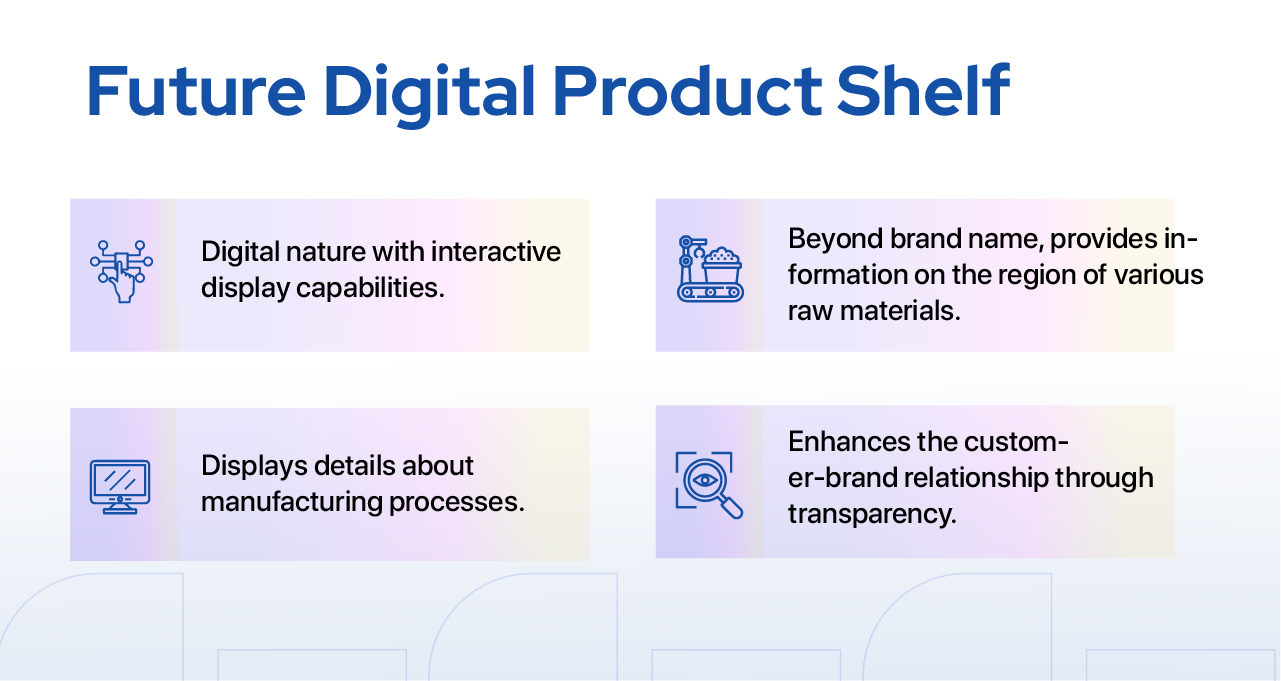 The Future Digital Product Shelf is a digitalized and interactive display in stores, offering more than brand names. It provides valuable information about the region of raw materials and details about manufacturing processes. This transparency enhances the relationship between customers and brands, fostering trust and informed purchasing decisions.
The Future Digital Product Shelf is a digitalized and interactive display in stores, offering more than brand names. It provides valuable information about the region of raw materials and details about manufacturing processes. This transparency enhances the relationship between customers and brands, fostering trust and informed purchasing decisions.
Intelligent Agents
Adaptive Assistance in Stores
1. Store Agents
2. Humanoids
3. Digital Assistants
Capabilities
- Real-time sensing and adaptation to customer needs.
- Facial expression recognition for humanoids.
- Identification of unhappy or dissatisfied customers.
- Intervention to address customer dissatisfaction.
- Alerting store manager for resolution.
The Adaptive Assistance system in stores employs intelligent agents, including Store Agents, Humanoids, and Digital Assistants. These agents possess capabilities such as real-time sensing and adaptation to customer needs. Humanoids, equipped with facial expression recognition, can identify unhappy customers, intervene to understand the reason for dissatisfaction, and alert the store manager for prompt resolution. This adaptive approach enhances customer satisfaction and the overall shopping experience.
Checkout FeaturesSeamless Checkout with Biometric Multi-Factor Authentication
1.Biometric Multi-Factor Authentication
2. Emotion Assessment for Shopping Experience
3. Selection of Delivery Speed
4. Dynamic Mobile Counters
Capabilities
- Real-time sensing and adaptation to customer needs.
- Facial expression recognition for humanoids.
- Identification of unhappy or dissatisfied customers.
- Intervention to address customer dissatisfaction.
- Alerting store manager for resolution.
The seamless checkout process incorporates biometric multi-factor authentication, emotion assessment for evaluating the shopping experience, and the ability to select the desired delivery speed. This dynamic approach is facilitated through mobile counters, ensuring a smooth and secure checkout experience. Customers can enjoy enhanced shopping experiences with the added convenience of flexible delivery speed options.
Delivery MixFuture Store Delivery Options
1. Traditional Delivery
2. Futuristic Options
3. Autonomous Drones
4. Delivery Robots
Collaborative Efforts
- Coordination Among Agents
- Tandem Work for Efficiency
Benefits
- Optimal Mix for Efficiency
- Traditional and Futuristic
- Collaboration for Seamless
- Delivery Process
The stores of the future will offer an optimal mix of both traditional and futuristic delivery options. This includes traditional delivery methods alongside advanced options like autonomous drones and delivery robots. These delivery agents will collaborate among themselves, working in tandem to ensure maximum efficiency in delivering products. The collaborative efforts involve coordination among different agents, resulting in a seamless and efficient delivery process.
Xenonstack capability
We have been striving through vision of creating a unified shopping experience by leveraging emerging technology like offerings like conversational user interface, machine vision driven customer tracking, facial biometrics in store analytics.
1. In-store analytics
Within store analytics, retail stores can draw customer insights (Understanding Customer Behavior, Analyzing Shopping Patterns), dwell time (Monitoring Time Spent in Sections, Identifying High-Traffic Areas) across various sections in the store and buying pattern.
2. Machine vision driven customer tracking
Machine vision-driven customer tracking utilizes advanced technology, leveraging store CCTV cameras. It enables the identification of customers, tracks their movements within the store, and provides contextual assistance based on real-time need assessments.
3. Location based services
Combining location-based services with a conversational interface, retail stores can run hyper-personalized promotional campaigns by utilizing the customer's location for targeted marketing. Conversational interfaces such as chatbots and assistants, like Amazon Alexa, are employed by enterprises to gather customer insights and efficiently manage vendors.
4. Cognitive platform
Using machine learning, we extract text from artwork images and categorize it into product attributes using blended reality techniques.
Challenges in Adopting Autonomous Retail Solutions
1. Data Privacy Concerns: Customers are apprehensive about potential misuse of data collected by technologies like computer vision.
2. Capital Expenditure Hurdles: Retailers face significant upfront costs when embracing autonomous-first solutions.
3. Retrofitting Existing Stores: Upgrading traditional stores with cameras or sensors is a time-consuming process, requiring the removal and restocking of products.
4. Product Displacement and Sensor Confusion: Shoppers displacing products can confuse sensors on shelves, impacting accurate inventory tracking.
5. Access Management for Restricted Products: Certain products, like alcohol, require restricted access based on age restrictions, posing challenges for autonomous checkout and staffing models.
6. Concerns About Job Displacement: Fear of job displacement due to automation, with projections suggesting the potential replacement of millions of retail jobs by automated kiosks.
Conclusion
With such advancements in technologies like computer visions and easier availability of sensors; It has paved way to emerging trends like checkout free retail, dark stores etc. This is the era for retailers who would be able to gather much more efficient insights and understand customer behavior within their stores using the mentioned emerging technologies aiding autonomous stores. These would help the stores achieve a seamless experience which will help in successfully building brand loyalty and creating customer mindshare. With the retail environment shifting from product-centricity to customer-centricity, it is important to provide an innovative way for retailers to stay relevant and meet customer demands through autonomous retail stores.
- Read More About : Real Time Analytics Tools and Benefit
- Explore More about : Top Real Time Analytics Use Cases
